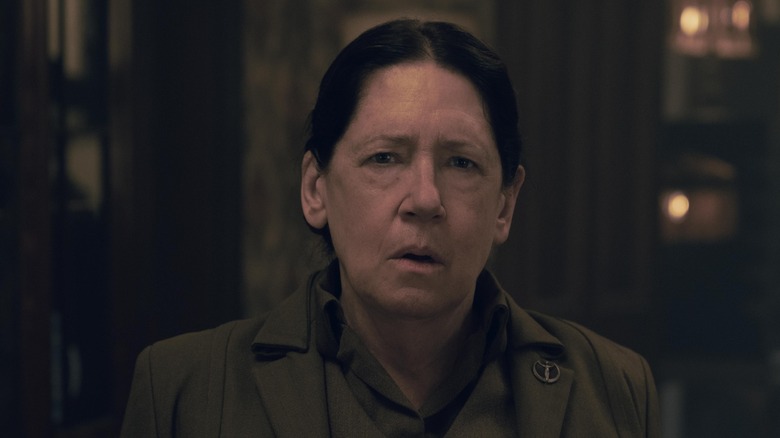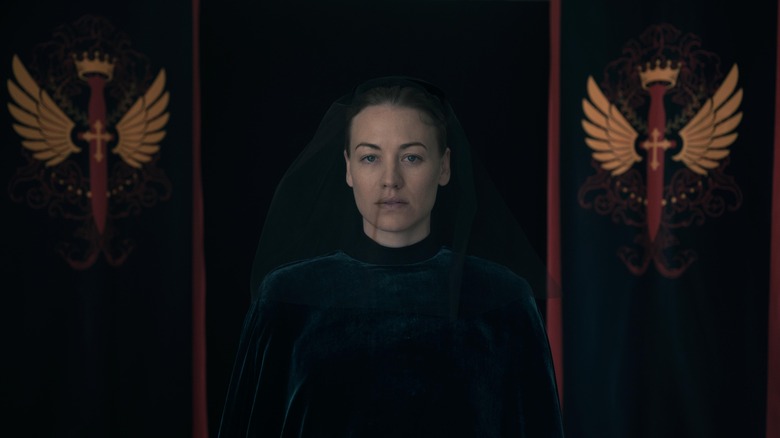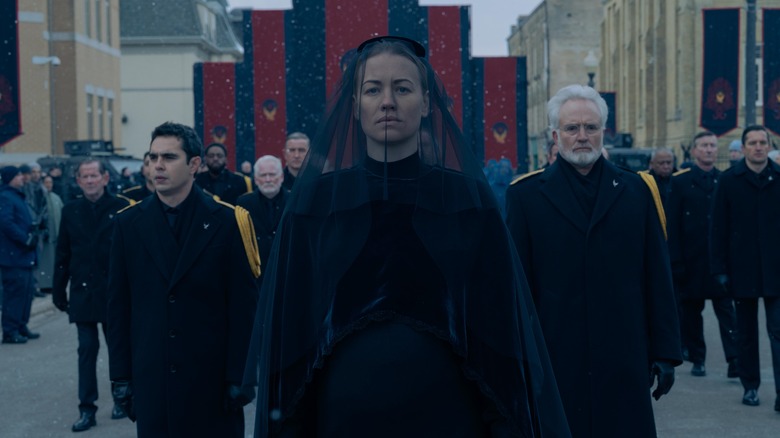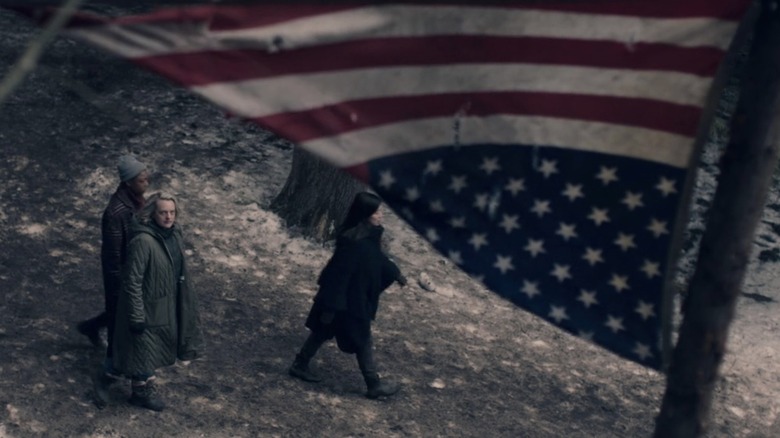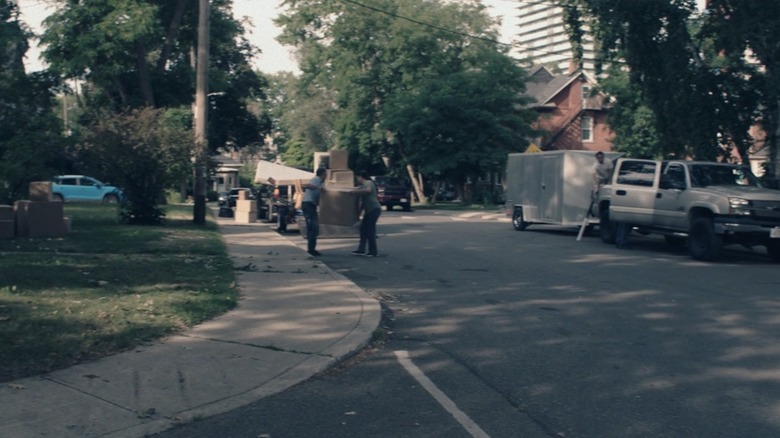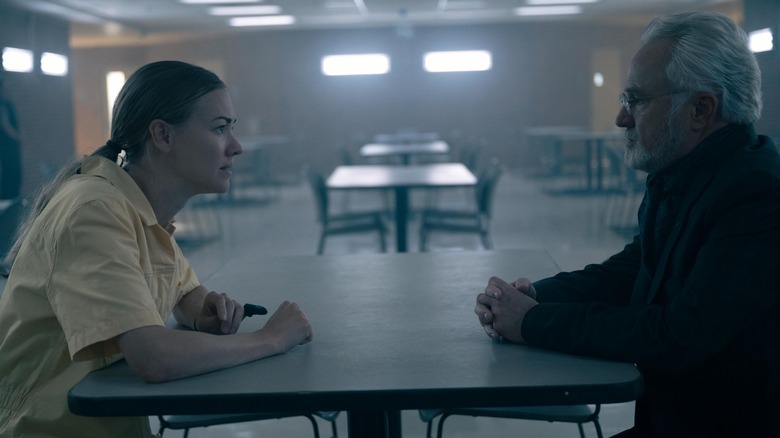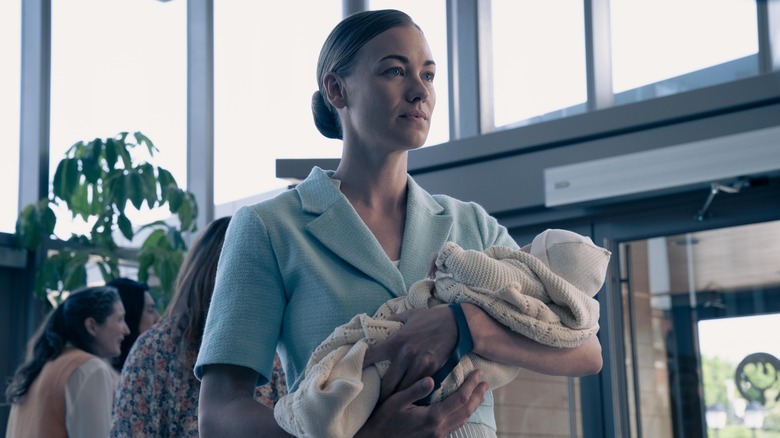Small Details You Missed In The Handmaid's Tale Season 5
Warning — spoilers ahead!
Season 5 of "The Handmaid's Tale" picks up right where Season 4 left off. June (Elisabeth Moss) is still covered in Commander Fred Waterford's (Joseph Fiennes) blood after a pack of Gilead refugees kill him with their bare hands in the no man's land between Canada and Gilead. After being told she will not face charges for killing Commander Waterford — because it happened in no man's land — June must try to move forward with her life in Canada with Luke (O-T Fagbenle), baby Nicole, and her best friend Moira (Samira Wiley).
Like any season of Hulu's hit series, Season 5 was rich with iconography and symbolism. Season 5 brings the startling realization that Gilead is gaining a foothold in Canada and depicts the shifting sentiment toward refugees in Toronto. Much of the season is a battle of wills between Serena Joy Waterford (Yvonne Strahovski), who is recently widowed and gets a taste of freedom in Canada, and June, who is hell-bent on exacting her revenge on Gilead while saving her daughter Hannah (Jordana Blake) from its clutches.
Viewers can expect sharp social commentary, political machinations, and a nuanced exploration of a terrifying dystopian vision of North America after a patriarchal theocracy has wrested power from the ruins of the U.S. Season 5 of "The Handmaid's Tale" has set us up for the 6th and final season of this phenomenal series. Keep reading as we discuss significant details you may have missed in Season 5.
Episodes 1 and 2 begin with the same song
Anyone who watches "The Handmaid's Tale" knows how important the soundtrack is. The song curation is meticulous and designed to elicit an emotional response. The Los Angeles Times wrote, "Often, the upbeat, instantly recognizable songs showcase the disparity and dark themes of the show by capturing what's absent from the world of 'The Handmaid's Tale.' Music, in fact, is banned by the fictional authoritarian regime of Gilead."
Episodes 1 and 2 are tied together by starting with the same song. In Episode 1, "All I Have to Do is Dream" by The Everly Brothers plays while June stands next to a running shower. She neglects to wash the blood from her hands because she is lost in a reverie as she savors the memory of killing Fred Waterford in Episode 10 of Season 4. However, as Commander Lawrence (Bradley Whitford) warned June at the end of Season 4, "It won't be enough, you know? Whatever happens to him won't be enough for you."
Episode 2 of Season 5 also begins with The Everly Brothers crooning as June lies in bed remembering all the awful things Serena Waterford did to her in Gilead while she was the Waterford's Handmaid. She gets out of bed and digs a hole in the yard to store her handgun. Commander Lawrence was right — a taste of retribution wasn't enough. Now that June has exacted vengeance against Fred, her revenge fantasies have turned to Serena.
The iconography for Handmaids is everywhere in Season 5
Despite Gilead being formed by a patriarchal, extremist Christian sect, the iconography Gilead adopted to be associated with Handmaids is a pagan symbol. A woman standing on a crescent moon, holding the horns of the moon with her arms outstretched is the design on Aunt Lydia's (Ann Dowd) broach, and this symbol is prominently featured in every single scene where Aunt Lydia graces the screen.
The moon has long been a pagan symbol associated with the divine feminine, women's monthly cycle, and pagan fertility goddesses. The symbol for Handmaids being borrowed from pagan symbols is pretty ironic, but as one Redditor pointed out, it isn't unusual for Christianity to borrow symbols and celebrations from the pagan cultures that preceded Christianity. Gilead is a theocracy created to combat declining fertility rates by reducing fertile women to chattel slavery as baby-making machines.
Considering how absolutely everything in Gilead, from the costumes and iconography on their flag and public institutions, represent people's place in their society, it isn't weird for Handmaids to be associated with symbolism that has long been associated with fertility. We see this reflected in the red habits the Handmaids wear. Ironically, the color red is also associated with passion, which is something the women of Gilead aren't allowed to express. This dual meaning of red in "The Handmaid's Tale" — in both the novel and the series — is obvious in how Handmaids are seen by those in Gilead both as sacred vessels and immoral temptresses.
Commanders in Gilead use a coat of arms
Some outlets, such as Movie Addicts, think Gilead debuted a new flag during Fred Waterford's funeral in Episode 2 of Season 5, as banners with new iconography and a more somber color scheme were displayed prominently during the funeral. This wouldn't be the first time Gilead's flag changed during the series, lending credence to this theory. Sean Schoffield, a graphic designer on "The Handmaid's Tale" team, told Refinery29, "The original flag of Gilead has more of a religious look to it." As noted by Refinery29, when June traveled to Washington D.C. with the Waterfords in Season 3, Episode 6, we see a new version of the flag with the original motif but a new color scheme reminiscent of Nazi Germany's red and black palette.
While it's possible Gilead used the funeral as an opportunity to display a new flag, there is another perspective you should consider. In Episode 2 we still see the red and black flag with a gold eagle displayed during Fred's funeral. However, there is also a new design, including a crown, cross, sword, and wings, evoking symbols of royalty, Christianity, and military might. This symbol isn't a new flag design — it is Commander Waterford's coat of arms.
Later in this episode, we learn using a coat of arms is a practice the Commanders in Gilead have adopted, as revealed when Mark Tuello (Sam Jaeger) asks Serena which Commander is associated with a coat of arms displayed on a card in a floral arrangement she received.
President Kennedy's funeral procession inspired Fred's funeral
In Episode 2 of Season 5 we witness Commander Waterford's funeral in Gilead. Serena travels back to Gilead under the supervision of Mark Tuello and fights for a spectacle to celebrate her dead husband's legacy. Despite his protests, Commander Lawrence argues her points and Serena gets her way. Praise be! Gilead even breaks from their tradition of privacy, broadcasting the over-the-top funeral to the world.
Show-runner Bruce Miller told Insider that Fred's funeral took cues from John F. Kennedy's, while producer Warren Littlefield noted that they were inspired by both the pageantry of Kennedy's funeral parade and the weather. Beyond that, Miller explained that Serena's veil was a nod to what Jacqueline Kennedy Onassis wore during her husband's funeral, as was the decision to have Serena walk alone behind the coffin. Even the riderless horse with backward boots in the stirrups and a saber, an ominous image symbolizing a fallen warrior, was borrowed from Kennedy's funeral.
Despite the funeral being for Fred, Serena is the focal point, and this episode makes it obvious Season 5 is a chess match between Serena and June as they fight for power. Producer Warren Littlefield told TVLine, "We talked a lot about that final ... image through that black veil, of Serena Joy and just how much that mouth curves into the slightest smile. Yes, she wants to honor Fred, but this is Serena Joy's stepping in and getting on the throne, and she's masterful. She's powerful. She's a great chess player."
The rebel border camp flies an inverted U.S. flag
Episode 3 of Season 5 sees Moira reluctantly tells June there is a border camp of rebels who have been successfully getting messages in and out of Gilead. They visit the border camp in an attempt to get a message into Gilead asking about the significance of the purple color Hannah wore during Commander Waterford's funeral. It is a color June and Moira never saw in Gilead, suggesting there are new programs.
June and Moira meet Lily (Christine Ko), who was one of the Gilead prisoners June traded for Commander Waterford, and they follow her to their destination. After arriving at a camp comprised of women, they follow Lily to a cabin in the woods. Outside the cabin, June pauses and looks up, noticing the rebels fly an inverted U.S. flag. This is a small detail, but it is significant. According to People, the U.S. Flag Code states that flying an inverted flag should only be done "as a signal of dire distress in instances of extreme danger to life or property."
Once inside the cabin, June not only learns that Mayday is real but that it is here, in Canada. According to Lily, "Mayday is everywhere." Moira is shocked Mayday hasn't been caught yet, but Lily tells her, "There's no, you know, flag or anything. It's outposts. Small, like this." These scenes cement the connection between the rebel network Mayday, which takes its name from the international signal for distress, and the symbol of the upside-down flag.
People are moving out of June's Toronto neighborhood in droves
One of the larger themes in Season 5 of "The Handmaid's Tale" is the liminal status refugees have in the country giving them amnesty. Throughout the season tensions in Toronto have been rising. As sentiment toward the U.S. refugees living in Canada become progressively negative and protestors become more aggressive, we also see the number of Gilead sympathizers in Canada growing. As Elizabeth Moss told Forbes, "We wanted to show how Gilead is spreading into Canada."
Tensions come to a head in Episode 9 when a candlelight vigil for the U.S. soldiers who have died is interrupted by gunfire. It is becoming increasingly clear that June, and other refugees living in Toronto, are no longer welcome in the city that embraced them when they escaped Gilead. You may have entirely missed this little detail — or completely forgotten about it after June gets run over by a Gilead sympathizer — but people are packing up and moving out of June's neighborhood in record numbers.
After walking Tuello to his car outside her home, June turns in a circle while standing in the street and realizes there are rent signs on front lawns and multiple households are packing up to move away. Have the Canadians decided if the refugees aren't leaving, they will? Are people moving to New Bethlehem? The mass exodus of refugees by train at the end of Episode 10 further suggests that refugees are fleeing Toronto.
Hannah signing her real name has more significance than you think
In Episode 9, while Luke and June wait with Tuello to learn the outcome of the military raid into Gilead that they hope will bring Hannah home, we see Hannah at the Wife School secretly writing her real name on a drawing she keeps hidden in the back of a bible. After writing her name, a hint of a smile touches Hannah's lips, suggesting this girl remembers who she is — and that she's just like her mother.
Elisabeth Moss told Forbes, "This hints at a future and a whole other story to tell." Forbes also notes that "The Handmaid's Tale" show-runner Bruce Miller is developing the follow-up series, "The Testaments," which continues the story years into the future. Hannah isn't a little girl anymore — she's in Wife School, and she will soon be forced into the role of a wife. Perhaps Hannah is the next generation of rebels coming of age in Gilead.
In Episode 6, Luke and June go into no man's land and meet with a young guard in Gilead. They bowl and laugh. It's a light moment where they remember a time when their lives weren't about saving Hannah from Gilead. Still, the festive moment is broken when the young man confides he doesn't really remember before Gilead. June and Luke must wonder if Hannah remembers them. When she signs her name, the audience, at least, gets an answer.
The yellow jumpsuit Serena wears in the detention center is important
If you've been watching "The Handmaid's Tale" for the last five seasons you know colors are significant. From the changing colors of the Gilead flag to the costumes people wear in Gilead, colors connote their place within their society. Handmaids wear red habits, white wings, and brown boots. Wives wear Gilead teal, blues, and greens. Aunts wear brown and khaki, while the domestic Marthas wear a grayish, muted green. Everyone has a place in Gilead society, and your clothes tell everyone what it is.
According to costume designer Leslie Kavanagh, dressing Serena in yellow was a strategic decision. Kavanagh told Express, "The yellow was for me to play against the severity of her situation. It was a juxtaposition." Kavanagh told Express she wanted visual differences between Gilead and Canada, and to do that, she tried to avoid primary colors in Canada. In the end, Kavanagh explained, "[Serena] is just a victim of her circumstance much like the Handmaids were, but in a different shade."
The most stunning visual cue of Serena's role reversal in the Wheeler household came in Episode 6 when a very pregnant Serena left the Wheeler's household with Ezra (Rossif Sutherland) to watch him kill June in no man's land. Serena is wearing a burgundy coat, while Mrs. Wheeler (Genevieve Angelson) is decked out in Gilead teal. Yvonne Strahovski told Digital Spy, "I think it was just such a clever way for the writers to make Serena a Handmaid without actually making her a Handmaid. I mean, it was perfect."
Pivotal female characters question their allegiance to Gilead
In Season 5 of "The Handmaid's Tale," many of our central characters are in a moral crisis. Elizabeth Moss explained to Forbes, "Everything is on the line for everybody, and they're all questioning their alliances, who and what they believe, whether they've made the right choices, what they're going to do, and whose side they will be on in this fight." We see this in many characters, including Nick Blaine (Max Minghella) and Commander Lawrence, but it is especially pronounced with two female characters.
Serena Joy, who has been loyal to Gilead from the beginning, questions her allegiance. However, after being turned away by Commander Lawrence and sent back to Canada as an unofficial ambassador, Serena gets a taste of freedom and power — and she likes it. Being treated as a Handmaid by the Wheelers and watching them essentially steal her newborn son while she's in a detention center forces Serena to run away with Noah, potentially making her a very valuable enemy against Gilead in Season 6.
Aunt Lydia's unquestioning loyalty to Gilead begins to crumble in Season 5. In Episode 4, she insists Commander Putnam (Stephen Kunken) face punishment for raping Esther (Mckenna Grace) and begs Commander Lawrence to institute a new Handmaid system. Aunt Lydia is pleased by Putnam's execution, but when Janine (Madeline Brewer) is taken by The Eyes in Episode 10, Aunt Lydia loses it, suggesting she just might turn rebel in Season 6 to protect "my girls."
Season 5 ends with the reverse of how Season 1 began
The premiere episode of Season 1 of "The Handmaid's Tale" began with June and Luke fleeing Gilead. They speed down a country road as cars pursue them with sirens blaring. After they wreck their Volvo, they must move through the woods on foot toward the Canadian border, where someone is waiting. The family is separated when Luke sends June and Hannah ahead of him into the woods. After leaving Luke behind, June hears gunshots and pauses, wondering if Luke has been killed. June and Hannah don't make it to the border — they are separated and trapped in Gilead. We later learn that Luke didn't die but found his way to Canada as a refugee after being injured in Gilead.
Episode 10 of Season 5 ends with June, Nicole, and Luke running away from Toronto after learning Luke will be charged with killing the man who attacked June. Tuello warns them that their flight to Hawaii has been flagged and helps them get new documentation and train tickets for the mass refugee exodus being orchestrated by the U.S. government in Toronto.
At the end of Season 5, they are separated once again when Luke sends June and Nicole ahead of him onto the train. He gives himself up to authorities while June and Nicole board a train full of refugees being relocated from Toronto to Vancouver, B.C. When June and Serena reunite on the westbound train, the final season of "The Handmaid's Tale" stretches out before us, promising one wild ride.


